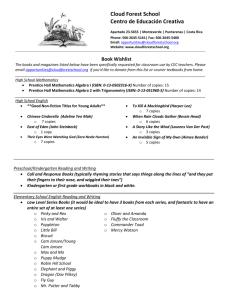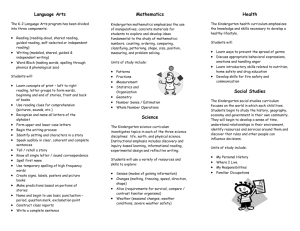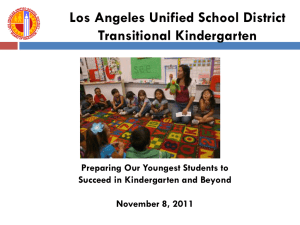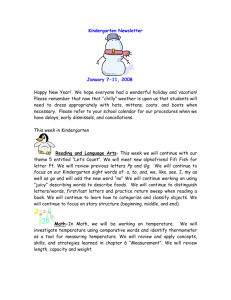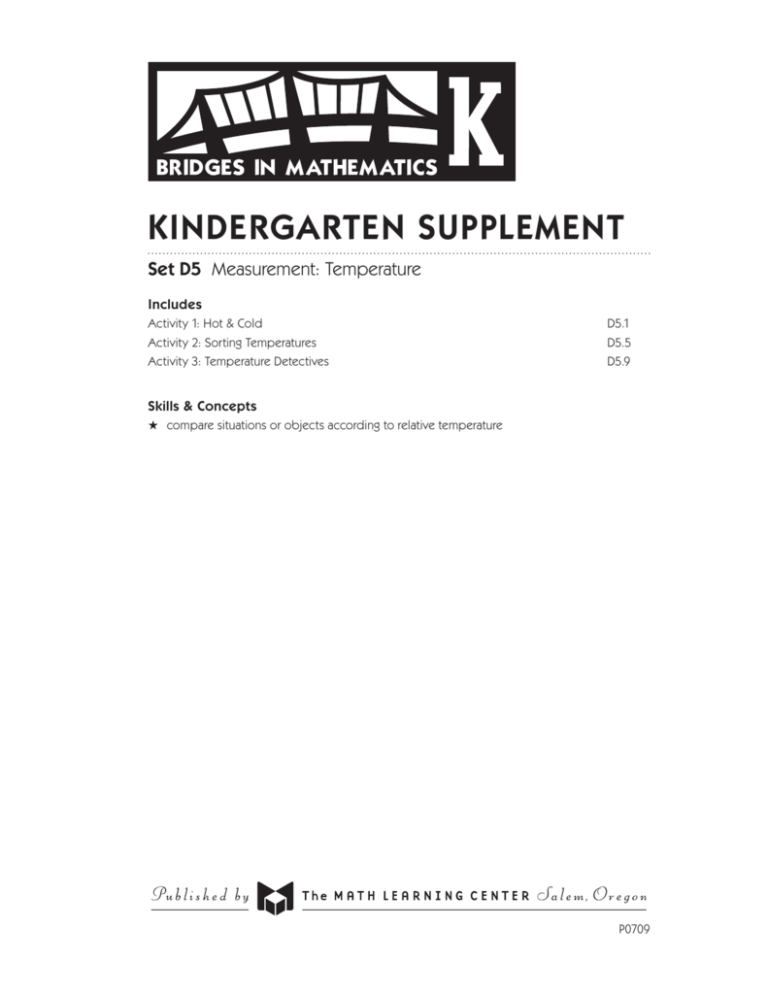
Kindergarten supplement
Set D5 Measurement: Temperature
Includes
Activity 1: Hot & Cold Activity 2: Sorting Temperatures
Activity 3: Temperature Detectives
D5.1
D5.5
D5.9
Skills & Concepts
H compare situations or objects according to relative temperature
P0709
Bridges in Mathematics Kindergarten Supplement
Set D5 Measurement: Temperature
The Math Learning Center, PO Box 12929, Salem, Oregon 97309. Tel. 1 800 575–8130.
© 2009 by The Math Learning Center
All rights reserved.
Prepared for publication on Macintosh Desktop Publishing system.
Printed in the United States of America.
P0709
The Math Learning Center grants permission to classroom teachers to reproduce blackline
masters in appropriate quantities for their classroom use.
Bridges in Mathematics is a standards-based K–5 curriculum that provides a unique blend
of concept development and skills practice in the context of problem solving. It incorporates the Number Corner, a collection of daily skill-building activities for students.
The Math Learning Center is a nonprofit organization serving the education community.
Our mission is to inspire and enable individuals to discover and develop their mathematical
confidence and ability. We offer innovative and standards-based professional development,
curriculum, materials, and resources to support learning and teaching. To find out more,
visit us at www.mathlearningcenter.org.
Set D5 Measurement: Temperature
Set D5 H Activity 1
Activity
Hot & Cold
Overview
You’ll need
Students discuss and illustrate hot and cold temperatures.
H Hot and Cold Labels (page D5.3, 1 copy, see Advance
Preparation)
Skills & Concepts
H compare situations or objects according to relative
temperature
H a piece of chart paper or butcher paper (see Advance
Preparation)
H drawing paper (class set plus a few extra)
H 3 thermometers from a science kit (optional)
H Four Seasons Make a Year by Anne Rockwell (optional)
Advance Preparation Fold the piece of chart paper
lengthwise and glue the 2 labels at the top.
Instructions for Hot & Cold
1. Gather students to your discussion circle. Display the chart you’ve prepared. Read the words “hot” and
“cold” and ask students to share any observations they can make about the illustrations. Record some of
their comments on the chart as the discussion proceeds.
Cold
H ot
The dog is really hot.
Maybe it’s summer.
• He’s sweating.
• His house is probably in the hot sun.
• The red stuff (mercury) in the
thermometer is way up at the top.
That means it’s really, really hot.
• He should go in the shade and cool off.
• He could go swimming.
The bird is standing in the snow.
Maybe it’s winter time.
• She’s probably warm because of
her feathers, but the air is cold.
• Maybe she should get a jacket on.
• The mercury in the thermometer
is down near the bottom. That
means it’s really cold.
• Snow is fun to play in.
• It’s cold like ice!
•
•
•
•
2. As students discuss the two pictures, be sure to elicit the fact that the temperature is hot in the first
picture and cold in the other, and that people use thermometers to measure the temperature. (Some stu-
© The Math Learning Center
Bridges in Mathematics Kindergarten Supplement • D5.1
Set D5 Measurement: Temperature
Activity 1 Hot & Cold (cont.)
dents might be interested to read the number of degrees shown on each thermometer, and a few may already associate readings like 90º with very hot days and readings like 20º with very cold days.)
3. Give each student a piece of drawing paper. Have them fold their paper in half and write “hot” at the
top of one side and “cold” at the top of the other. Then ask them to draw a picture to illustrate both temperatures. You may want to brainstorm a few ideas with the children before they begin. Here are some
questions to elicit student thinking.
• What kinds of things do you do outdoors when it’s hot? when it’s cold?
• How do you dress for very hot or very cold weather?
• What do people do to stay cool when the temperature outside is hot? What do they do to stay warm
when the temperature outside is cold?
• Can you think of places in the world where it’s very hot or very cold?
• What kinds of animals live in very hot climates? very cold climates?
4. When students are finished, display their artwork on a classroom wall or have them take it home to
share with their families.
Extensions
• Read Four Seasons Make a Year by Anne Rockwell, before or after this activity. There are many other
weather-related books you might share with your class as well.
• Set out a container of hot water, a container of lukewarm water, and a container of ice water along
with 3 student thermometers from a science kit during choosing time or Work Places, on several different days. Encourage students to feel the temperature of the water in each container and measure
it with a thermometer.
D5.2 • Bridges in Mathematics Kindergarten Supplement
© The Math Learning Center
Hot & Cold Labels
Hot Cold
Set D5 Measurement: Temperature Blackline Run 1 copy, and cut the labels apart.
© The Math Learning Center
Bridges in Mathematics Kindergarten Supplement • D5.3
D5.4 • Bridges in Mathematics Kindergarten Supplement
© The Math Learning Center
Set D5 Measurement: Temperature
Set D5 H Activity 2
Activity
Sorting Temperatures
Overview
You’ll need
Students sort pictures that show hot and cold temperatures.
H Hot & Cold Sorting Pictures (pages D5.7 and D5.8,
class set of each)
H Hot & Cold chart made in Set D5 Activity 1
Skills & Concepts
H compare situations or objects according to relative
temperature
H a piece of 12˝ × 18˝ paper for each student
Recommended Timing
H glue sticks
H scissors
Anytime after Set D5 Activity 1
Instructions for Sorting Temperatures
1. Gather students to your discussion circle. Revisit the Hot and Cold chart you made with the class in
Set D5 Activity 1. How would students compare the temperature of your classroom to the two pictures
on the chart? How does the weather outside right now compare to the two pictures? Is it hot, cold, or
somewhere in between? Can they think of a place where the temperature would be as hot (or cold) right
now as what’s shown in the picture on the chart?
H ot
Cold
The dog is really hot.
• The bird is standing in the snow.
Maybe it’s summer.
• Maybe it’s winter time.
• He’s sweating.
• She’s probably warm because of
2. Next, show the 2 sheets of Hot and Cold Sorting Pictures
you’ve prepared for each of them. Examine
• His house is probably in the hot sun.
her feathers, but the air is cold.
a few of the pictures together• The
and
thein temperature
insheeach.
How
can
reddiscuss
stuff (mercury)
the
• Maybe
should get
a jacket
on. they tell if the temperature
thermometer
is
way
up
at
the
top.
•
The
mercury
in
the
thermometer
in each picture is hot or cold?
That means it’s really, really hot.
is down near the bottom. That
• He should go in the shade and cool off.
really
cold. look like winter.
Students The hot ones all look like summer, andmeans
the it’s
cold
ones
• He could go swimming.
• Snow is fun to play in.
Some of the really cold ones have snow.
• It’s cold like ice!
•
•
The kids have jackets in the cold ones and stuff like swimsuits in the hot ones.
If it doesn’t come from some of the students, draw their attention to the thermometer in the pictures.
Do these help us tell whether the temperature in the picture is hot or cold? If so, how? (While some students may not be able to read the numbers, many will be able to make a connection between the height
of the mercury and the conditions shown in the pictures.)
© The Math Learning Center
Bridges in Mathematics Kindergarten Supplement • D5.5
Set D5 Measurement: Temperature
Activity 2 Sorting Temperatures (cont.)
Students The line is near the top on the hot pictures.
It’s down near the bottom on the really cold pictures.
The numbers are higher on the hot pictures, like one of those says one-oh-four. That’s one hundred
and four degrees. That’s really hot!
3. Show students a piece of 12" × 18" paper. Fold it in half, label one side with the word “hot” and the
other with “cold”, and then model cutting out a few of the pictures and gluing them to the correct side.
4. Once students understand what to do, have them return to their tables and get out their scissors and
glue sticks as you pass out paper and copies of the blacklines. You’ll probably want to write the words
“hot” and “cold” on the board for students to copy. Circulate as they work, giving assistance as needed,
and conversing with students about the situations shown in each picture. Encourage them to think
about how the temperatures in various pictures feel to the children in those pictures. Have they been in
similar situations? Do they like hot weather temperatures or cold weather temperatures better?
Note If you feel that it’s more appropriate for some of your students to cut, sort, and glue 6 pictures instead
of 12, distribute one of the blacklines to each student to begin, and then give them the second sheet as they’re
ready. Also, some students may enjoy taking the second sheet home along with their sorting paper and finishing the project at home.
D5.6 • Bridges in Mathematics Kindergarten Supplement
© The Math Learning Center
Set D5 Measurement: Temperature Blackline Run a class set.
Hot & Cold Sorting Pictures, page 1 of 2
© The Math Learning Center
Bridges in Mathematics Kindergarten Supplement • D5.7
Set D5 Measurement: Temperature Blackline Run a class set.
Hot & Cold Sorting Pictures, page 2 of 2
D5.8 • Bridges in Mathematics Kindergarten Supplement
© The Math Learning Center
Set D5 Measurement: Temperature
Set D5 H Activity 3
Activity
Temperature Detectives
Overview
You’ll need
Students take a short walk around the school, looking for
hotter and colder locations.
H 3˝ squares of red and blue construction paper (10–15
of each)
Skills & Concepts
H compare situations or objects according to relative
temperature
Recommended Timing
Anytime after Set D5 Activity 1
H a roll of masking tape
H wide-tip black felt marker
H an outdoor thermometer (optional)
Advance Preparation Walk around your school before you conduct this activity to find locations that feel
warmer or cooler relative to one another. Depending on
your local climate, the season, and the nature (and age) of
your school building, cool locations may include storerooms, shady or exposed outdoor areas, and the custodian’s closet. Perhaps there’s a refrigerator and/or a freezer
somewhere in the school. Warmer locations may include
the boiler room, protected (or exposed outdoor areas),
glassed-in areas that get a lot of sun, and so on.
You’ll also need to make arrangements in advance with
the gym or music teacher, the librarian, or an aide to supervise half your class while you’re working with the other
half for about 10 minutes, and then switch groups with
you for another 10 minutes.
Instructions for Temperature Detectives
1. Gather children to your discussion circle. Let them know that they’re going to be temperature detectives today, walking around the school to see if they can find cool (or even cold) places and warm (or
even hot) places. Show them the construction paper squares and masking tape. Then explain that you’ll
take half the class first while the others stay with your aide (or go to gym or music, or whatever you’ve
arranged). These children will mark each cool/cold location they find by taping a blue square on or near
it. They’ll mark each warm/hot location they find with a red square. Later, you’ll take the other half of
the class on the same route. They’ll get to be the inspectors, collecting each paper square the first half
left and marking it with a star if they agree and a zero if they don’t.
© The Math Learning Center
Bridges in Mathematics Kindergarten Supplement • D5.9
Set D5 Measurement: Temperature
Activity 3 Temperature Detectives (cont.)
2. Take the first half of the class out along the route you’ve pre-planned. Ask them to feel the temperature carefully as they walk. Even if they have their coats on, they can still feel the air with their hands
and faces. As them to stay as close to you as possible, and move as quietly as possible—good detectives
never find what they’re looking for unless they’re very quiet and very careful. When they come to a
place that feels particularly hot or cold, have them raise their hands as a signal. If most children in the
group agree, mark the location with a blue square for cool or cold or a red square for warm or hot.
3. After about 10 minutes, return to class and take the other group out to inspect the work of the first
group. Be sure to take your black felt marker along. Although they’ll be excited to spot the squares of
paper along the route, ask these children to move very carefully and quietly. Inspectors have to be even
more careful than detectives! Collect each paper square left by the first group and mark it with a star or
a zero, depending on whether or not the inspectors agree with the detectives’ judgment of the temperature in that location.
4. When you return to class with the second group, reconvene the entire class. Ask students to share
their experiences on the walk with the group. Here are some questions you might want to pose as the
discussion unfolds.
• Did the inspectors agree with the detectives most of the time?
• How might students explain cases where there was disagreement? (The judgments of each group
are very subjective, and it’s possible that temperatures actually changed. For instance, if it was quite
windy when the first group went out, they may have identified some locations outside that warmed
up when the wind died down.)
• Where are some of the warmest spots around the school? the coolest? Will these change as the seasons change? Why? Will some of them stay the same, no matter what the season? Why? Extensions
• If you have an outdoor thermometer, you might want to take it with you when you go out with both
groups. If the temperature changes are dramatic enough from one location to another, students will
be able to see the mercury (or alcohol, most likely) rise and fall as they watch.
• Ask each student to draw a picture one of the locations they found along the walk and label it with
the word “cool”, “cold”, “warm”, or “hot”. Display the collection in the hallway along with an explanation of the activity for parents, teachers, and older students to read.
D5.10 • Bridges in Mathematics Kindergarten Supplement
© The Math Learning Center


